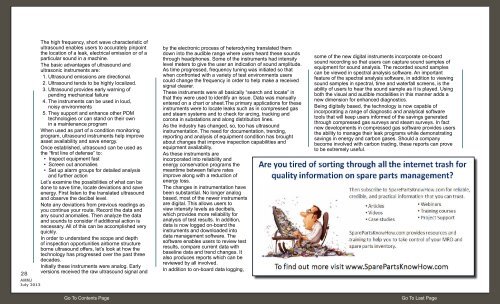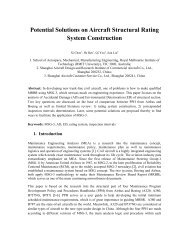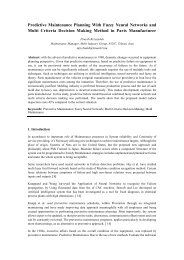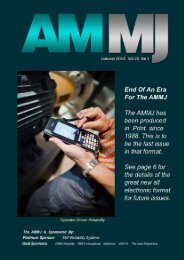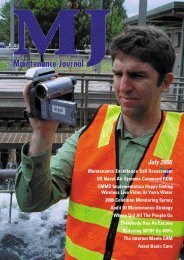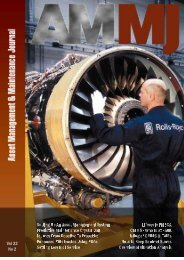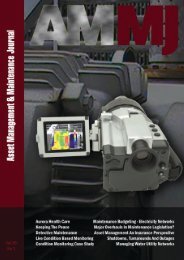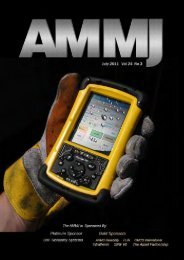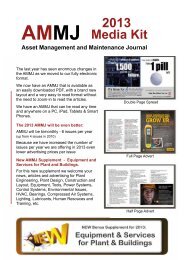Maintenance & Reliability News - Maintenance Journal
Maintenance & Reliability News - Maintenance Journal
Maintenance & Reliability News - Maintenance Journal
You also want an ePaper? Increase the reach of your titles
YUMPU automatically turns print PDFs into web optimized ePapers that Google loves.
28<br />
AMMJ<br />
July 2013<br />
The high frequency, short wave characteristic of<br />
ultrasound enables users to accurately pinpoint<br />
the location of a leak, electrical emission or of a<br />
particular sound in a machine.<br />
The basic advantages of ultrasound and<br />
ultrasonic instruments are:<br />
1. Ultrasound emissions are directional.<br />
2. Ultrasound tends to be highly localized.<br />
3. Ultrasound provides early warning of<br />
pending mechanical failure<br />
4. The instruments can be used in loud,<br />
noisy environments<br />
5. They support and enhance other PDM<br />
technologies or can stand on their own<br />
in a maintenance program<br />
When used as part of a condition monitoring<br />
program, ultrasound instruments help improve<br />
asset availability and save energy.<br />
Once established, ultrasound can be used as<br />
the “first line of defense” to:<br />
• Inspect equipment fast<br />
• Screen out anomalies<br />
• Set up alarm groups for detailed analysis<br />
and further action<br />
Let’s examine the possibilities of what can be<br />
done to save time, locate deviations and save<br />
energy. First listen to the translated ultrasound<br />
and observe the decibel level.<br />
Note any deviations from previous readings as<br />
you continue your route. Record the data and<br />
any sound anomalies. Then analyze the data<br />
and sounds to consider if additional action is<br />
necessary. All of this can be accomplished very<br />
quickly.<br />
In order to understand the scope and depth<br />
of inspection opportunities airborne structure<br />
borne ultrasound offers, let’s look at how the<br />
technology has progressed over the past three<br />
decades.<br />
Initially these instruments were analog. Early<br />
versions received the raw ultrasound signal and<br />
by the electronic process of heterodyning translated them<br />
down into the audible range where users heard these sounds<br />
through headphones. Some of the instruments had intensity<br />
level meters to give the user an indication of sound amplitude.<br />
As time progressed, frequency tuning was initiated so that<br />
when confronted with a variety of test environments users<br />
could change the frequency in order to help make a received<br />
signal clearer.<br />
These instruments were all basically “search and locate” in<br />
that they were used to identify an issue. Data was manually<br />
entered on a chart or sheet.The primary applications for these<br />
instruments were to locate leaks such as in compressed gas<br />
and steam systems and to check for arcing, tracking and<br />
corona in substations and along distribution lines.<br />
As the industry has changed, so, too has ultrasound<br />
instrumentation. The need for documentation, trending,<br />
reporting and analysis of equipment condition has brought<br />
about changes that improve inspection capabilities and<br />
equipment availability.<br />
As these instruments are<br />
incorporated into reliability and<br />
energy conservation programs the<br />
meantime between failure rates<br />
improve along with a reduction of<br />
energy loss.<br />
The changes in instrumentation have<br />
been substantial. No longer analog<br />
based, most of the newer instruments<br />
are digital. This allows users to<br />
view intensity levels as decibels,<br />
which provides more reliability for<br />
analysis of test results. In addition,<br />
data is now logged on-board the<br />
instruments and downloaded into<br />
data management software. The<br />
software enables users to review test<br />
results, compare current data with<br />
baseline data and trend changes. It<br />
also produces reports which can be<br />
reviewed by all involved.<br />
In addition to on-board data logging,<br />
some of the new digital instruments incorporate on-board<br />
sound recording so that users can capture sound samples of<br />
equipment for sound analysis. The recorded sound samples<br />
can be viewed in spectral analysis software. An important<br />
feature of the spectral analysis software, in addition to viewing<br />
sound samples in spectral, time and waterfall screens, is the<br />
ability of users to hear the sound sample as it is played. Using<br />
both the visual and audible modalities in this manner adds a<br />
new dimension for enhanced diagnostics.<br />
Being digitally based, the technology is now capable of<br />
incorporating a range of diagnostic and analytical software<br />
tools that will keep users informed of the savings generated<br />
through compressed gas surveys and steam surveys. In fact<br />
new developments in compressed gas software provides users<br />
the ability to manage their leak programs while demonstrating<br />
savings in energy and carbon gases. Should a company<br />
become involved with carbon trading, these reports can prove<br />
to be extremely useful.<br />
Go To Contents Page<br />
Go To Last Page


